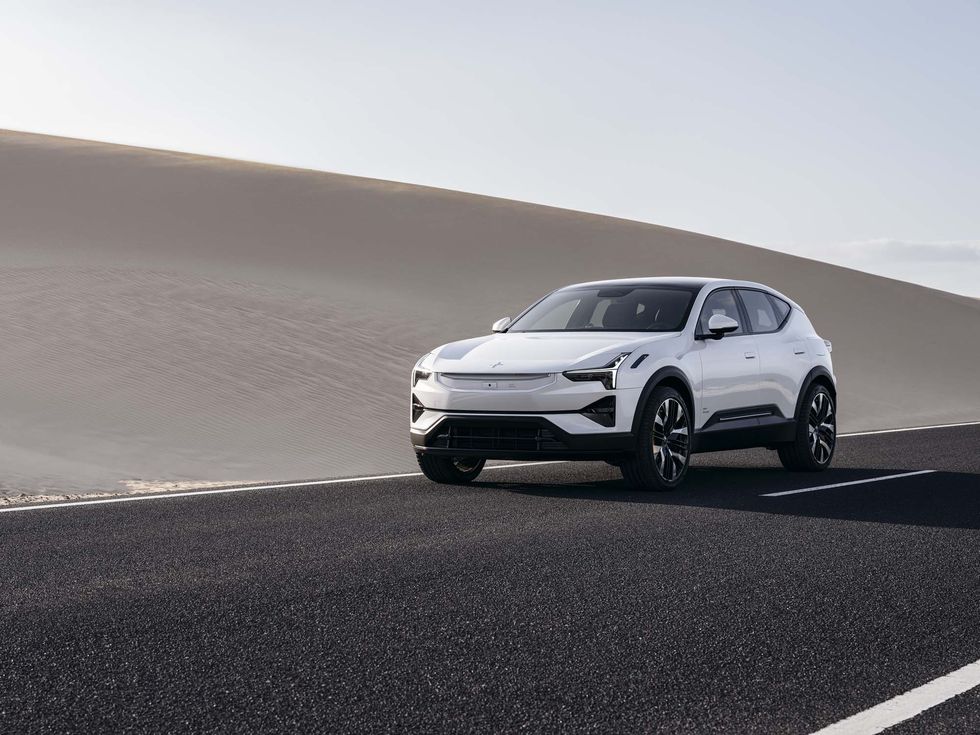
To answer your first question, Polestar is a subsidiary of Volvo and is made to compete in the luxury performance EV market. Debuting with the PHEV Polestar 1 in 2017 and then the Polestar 2 sedan shortly thereafter, it only seems fitting that its newest offering follows sequentially as the Polestar 3. Read on for answers to just about every (other) question you may have regarding this intriguing new vehicle.

What exactly is the Polestar 3?
Set to compete with the Porsche Macan 4 and Tesla Model X, the Polestar 3 shares a version of Volvo’s global SPA2 platform with the Volvo EX90. The P3 will be a two-row, all-wheel-drive midsize luxury SUV.
What is the Polestar 3’s range?
Even more of a concern than MPGs were back in the gas crisis of the ’70s (and arguably the late 2000s), an EV’s range is generally the first or second question anyone has. The Polestar 3 is powered by a 111-kWh battery pack, which can be utilized in one of two trims. According to Polestar, the base Long Range Dual Motor has a range of up to 315 miles. That number drops somewhat precipitously with the addition of the Performance Pack, which increases power at the cost of additional miles. Still, the more powerful variant is able to hit 279 miles of range under ideal conditions.
How fast can the Polestar 3 charge?
The P3 is compatible with a variety of public chargers. According to Polestar, using a 250 kW DC faster charger, the P3 can charge from 10 to 80% in just 30 minutes. The company also offers this helpful bit of advice for longer road trips:
Save time by charging to 80%
On a long trip, it’s more effective to plug into a rapid DC charger twice, charging up to 80%, than to stop once and charge to 100%. The final 20% capacity of an EV’s lithium-ion battery charges at a slower rate, extending the charging time.

How much power does the Polestar 3 make?
In its base trim, the P3 makes up to 360 kW, which translates into a whopping 489 hp and 620 lb-ft of torque. The additional Performance Pack ratchets those figures up to 380 kW, 517 hp and 671 lb-ft of torque.
How fast is the Polestar 3?
Like most dual-motor EVs, the Polestar 3 has one motor at each end of the car to power the front and rear wheels separately. When full power is not needed, the P3 can disconnect the rear motor to allow for maximum range.
When full power is engaged, however, the base car can rocket from 0-60 mph in a scant 4.8 seconds, while the more powerful Performance Pack-equipped models can drop that sprint from 0-60 mph to just 4.5 seconds.

What does the interior of the Polestar 3 look like?
In a very Tesla-like minimalist fashion, the P3 keeps things simple and elegant. A large central-mounted touchscreen dominates the dashboard, while a digital gauge cluster provides all the pertinent data a driver needs to know about speed, range, and navigation (among other selectable features). Clean lines, insulated glass, a Bowers & Wilkins audio system, and available Nappa leather all serve to provide P3 passengers with as serene a driving experience as a morning commute will allow.

When will the Polestar 3 be available?
Production for the newest Polestar has already begun, and orders are being taken for new models on the company’s website. Deliveries are slated to begin in May of 2024.
How much is a new Polestar 3?
The base MSRP for a new Polestar 3 is $73,400. Adding the Performance Pack bumps that price up by another $5,000. If you’d like all the bells and whistles (larger wheels, leather, heated rear seats, etc), then be prepared to begin negotiations at $84,900.
Does the Polestar 3 quality for the $7,500 tax credit?
Yes and no. As of this writing, the P3 is not on the eligible list of EV SUVs you can purchase and receive the $7,500 incentive. However, that same $7,500 is available to apply towards leasing a new Polestar 3.



